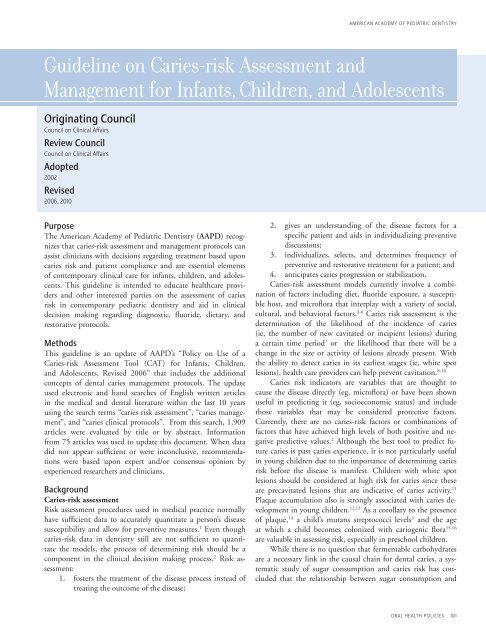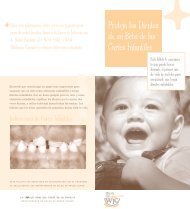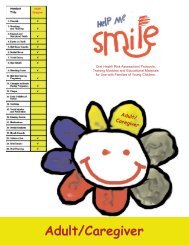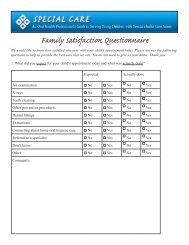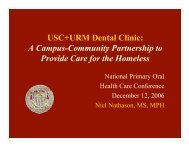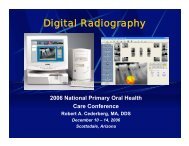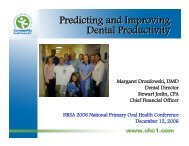Dental Caries Risk Assessment - Maryland Academy of Pediatric ...
Dental Caries Risk Assessment - Maryland Academy of Pediatric ...
Dental Caries Risk Assessment - Maryland Academy of Pediatric ...
- No tags were found...
Create successful ePaper yourself
Turn your PDF publications into a flip-book with our unique Google optimized e-Paper software.
AMERICAN ACADEMY OF PEDIATRIC DENTISTRYGuideline on <strong>Caries</strong>-risk <strong>Assessment</strong> andManagement for Infants, Children, and AdolescentsOriginating CouncilCouncil on Clinical AffairsReview CouncilCouncil on Clinical AffairsAdopted2002Revised2006, 2010PurposeThe American <strong>Academy</strong> <strong>of</strong> <strong>Pediatric</strong> Dentistry (AAPD) recognizesthat caries-risk assessment and management protocols canassist clinicians with decisions regarding treatment based uponcaries risk and patient compliance and are essential elements<strong>of</strong> contemporary clinical care for infants, children, and adolescents.This guideline is intended to educate healthcare providersand other interested parties on the assessment <strong>of</strong> cariesrisk in contemporary pediatric dentistry and aid in clinicaldecision making regarding diagnostic, fluoride, dietary, andrestorative protocols.MethodsThis guideline is an update <strong>of</strong> AAPD’s “Policy on Use <strong>of</strong> a<strong>Caries</strong>-risk <strong>Assessment</strong> Tool (CAT) for Infants, Children,and Adolescents, Revised 2006” that includes the additionalconcepts <strong>of</strong> dental caries management protocols. The updateused electronic and hand searches <strong>of</strong> English written articlesin the medical and dental literature within the last 10 yearsusing the search terms “caries risk assessment”, “caries management”,and “caries clinical protocols”. From this search, 1,909articles were evaluated by title or by abstract. Informationfrom 75 articles was used to update this document. When datadid not appear sufficient or were inconclusive, recommendationswere based upon expert and/or consensus opinion byexperienced researchers and clinicians.Background<strong>Caries</strong>-risk assessment<strong>Risk</strong> assessment procedures used in medical practice normallyhave sufficient data to accurately quantitate a person’s diseasesusceptibility and allow for preventive measures. 1 Even thoughcaries-risk data in dentistry still are not sufficient to quantitatethe models, the process <strong>of</strong> determining risk should be acomponent in the clinical decision making process. 2 <strong>Risk</strong> assessment:1. fosters the treatment <strong>of</strong> the disease process instead <strong>of</strong>treating the outcome <strong>of</strong> the disease;2. gives an understanding <strong>of</strong> the disease factors for aspecific patient and aids in individualizing preventivediscussions;3. individualizes, selects, and determines frequency <strong>of</strong>preventive and restorative treatment for a patient; and4. anticipates caries progression or stabilization.<strong>Caries</strong>-risk assessment models currently involve a combination<strong>of</strong> factors including diet, fluoride exposure, a susceptiblehost, and micr<strong>of</strong>lora that interplay with a variety <strong>of</strong> social,cultural, and behavioral factors. 3-6 <strong>Caries</strong> risk assessment is thedetermination <strong>of</strong> the likelihood <strong>of</strong> the incidence <strong>of</strong> caries(ie, the number <strong>of</strong> new cavitated or incipient lesions) duringa certain time period 7 or the likelihood that there will be achange in the size or activity <strong>of</strong> lesions already present. Withthe ability to detect caries in its earliest stages (ie, white spotlesions), health care providers can help prevent cavitation. 8-10<strong>Caries</strong> risk indicators are variables that are thought tocause the disease directly (eg, micr<strong>of</strong>lora) or have been shownuseful in predicting it (eg, socioeconomic status) and includethose variables that may be considered protective factors.Currently, there are no caries-risk factors or combinations <strong>of</strong>factors that have achieved high levels <strong>of</strong> both positive and negativepredictive values. 2 Although the best tool to predict futurecaries is past caries experience, it is not particularly usefulin young children due to the importance <strong>of</strong> determining cariesrisk before the disease is manifest. Children with white spotlesions should be considered at high risk for caries since theseare precavitated lesions that are indicative <strong>of</strong> caries activity. 11Plaque accumulation also is strongly associated with caries developmentin young children. 12,13 As a corollary to the presence<strong>of</strong> plaque, 14 a child’s mutans streptococci levels 3 and the ageat which a child becomes colonized with cariogenic flora 15,16are valuable in assessing risk, especially in preschool children.While there is no question that fermentable carbohydratesare a necessary link in the causal chain for dental caries, a systematicstudy <strong>of</strong> sugar consumption and caries risk has concludedthat the relationship between sugar consumption andoral health policies 101
eference manual v 32 / no 6 10 / 11caries is much weaker in the modern age <strong>of</strong> fluoride exposurethan previously thought. 17 However, there is evidence thatnight-time use <strong>of</strong> the bottle, especially when it is prolonged,may be associated with early childhood caries. 18 Despite the factthat normal salivary flow is an extremely important intrinsichost factor providing protection against caries, there is littledata about the prevalence <strong>of</strong> low salivary flow in children. 19,20Sociodemographic factors have been studied extensively todetermine their effect on caries risk. Children with immigrantbackgrounds have 3 times higher caries rates than nonimmigrants.21 Most consistently, an inverse relationship betweensocioeconomic status and caries prevalence is found instudies <strong>of</strong> children less than 6 years <strong>of</strong> age. 22 Perhaps anothertype <strong>of</strong> sociodemographic variable is the parents’ history <strong>of</strong>cavities and abscessed teeth; this has been found to be a predictor<strong>of</strong> treatment for early childhood caries. 23,24The most studied factors that are protective <strong>of</strong> dentalcaries include systemic and topical fluoride, sugar substitutes,and tooth brushing with fluoridated toothpaste. Teeth <strong>of</strong> childrenwho reside in a fluoridated community have been shownto have higher fluoride content than those <strong>of</strong> children whoreside in suboptimal fluoridated communities. 25 Additionally,both pre- and post-eruption fluoride exposure maximize thecaries-preventive effects. 26,27 For individuals residing in nonfluoridatedcommunities, fluoride supplements have shown asignificant caries reduction in primary and permanent teeth. 28With regard to fluoridated toothpaste, studies have shownconsistent reduction in caries experience. 29 Pr<strong>of</strong>essional topicalfluoride applications performed semiannually also reducecaries, 30 and fluoride varnishes generally are equal to that <strong>of</strong>other pr<strong>of</strong>essional topical fluoride vehicles. 31The effect <strong>of</strong> sugar substitutes on caries rates have beenevaluated in several populations with high caries prevalence. 32Studies indicate that xylitol can decrease mutans streptococcilevels in plaque and saliva and can reduce dental cariesin young children and adults, including children via theirmothers. 33 With regard to toothbrushing, there only is a weakrelationship between frequency <strong>of</strong> brushing and decreaseddental caries, which is confounded because it is difficult todistinguish whether the effect is actually a measure <strong>of</strong> fluorideapplication or whether it is a result <strong>of</strong> mechanical removal <strong>of</strong>plaque. 34 The dental home or regular periodic care by thesame practitioner is included in many caries-risk assessmentmodels because <strong>of</strong> its known benefit for dental health. 35<strong>Risk</strong> assessment tools can aid in the identification <strong>of</strong> reliablepredictors and allow dental practitioners, physicians,and other nondental health care providers to become more activelyinvolved in identifying and referring high-risk children.Tables 1, 2, and 3 incorporate available evidence into practicaltools to assist dental practitioners, physicians, and other nondentalhealth care providers in assessing levels <strong>of</strong> risk for cariesdevelopment in infants, children, and adolescents. As new evidenceemergences, these tools can be refined to provide greaterpredictably <strong>of</strong> caries in children prior to disease initiation.Table 1. <strong>Caries</strong>-risk <strong>Assessment</strong> Form for 0-3 Year Olds 59,60(For Physicians and Other Non-<strong>Dental</strong> Health Care Providers)Factors High <strong>Risk</strong> Moderate <strong>Risk</strong> ProtectiveBiologicalMother/primary caregiver has active cavitiesParent/caregiver has low socioeconomic statusChild has >3 between meal sugar-containing snacks or beverages per dayChild is put to bed with a bottle containing natural or added sugarChild has special health care needsChild is a recent immigrantYesYesYesYesYesYesProtectiveChild receives optimally-fluoridated drinking water or fluoride supplementsChild has teeth brushed daily with fluoridated toothpasteChild receives topical fluoride from health pr<strong>of</strong>essionalChild has dental home/regular dental careYesYesYesYesClinical FindingsChild has white spot lesions or enamel defectsChild has visible cavities or fillingsChild has plaque on teethYesYesYesCircling those conditions that apply to a specific patient helps the health care worker and parent understand the factors that contribute toor protect from caries. <strong>Risk</strong> assessment categorization <strong>of</strong> low, moderate, or high is based on preponderance <strong>of</strong> factors for the individual.However, clinical judgment may justify the use <strong>of</strong> one factor (eg, frequent exposure to sugar containing snacks or beverages, visible cavities)in determining overall risk.Overall assessment <strong>of</strong> the child’s dental caries risk: High Moderate Low 102 oral health policies
AMERICAN ACADEMY OF PEDIATRIC DENTISTRYTable 2. <strong>Caries</strong>-risk <strong>Assessment</strong> Form for 0-5 Year Olds 59,60(For <strong>Dental</strong> Providers)Factors High <strong>Risk</strong> Moderate <strong>Risk</strong> ProtectiveBiologicalMother/primary caregiver has active cariesParent/caregiver has low socioeconomic statusChild has >3 between meal sugar-containing snacks or beverages per dayChild is put to bed with a bottle containing natural or added sugarChild has special health care needsChild is a recent immigrantYesYesYesYesYesYesProtectiveChild receives optimally-fluoridated drinking water or fluoride supplementsChild has teeth brushed daily with fluoridated toothpasteChild receives topical fluoride from health pr<strong>of</strong>essionalChild has dental home/regular dental careYesYesYesYesClinical FindingsChild has >1 decayed/missing/filled surfaces (dmfs)Child has active white spot lesions or enamel defectsChild has elevated mutans streptococci levelsChild has plaque on teethYesYesYesYesCircling those conditions that apply to a specific patient helps the practitioner and parent understand the factors that contribute toor protect from caries. <strong>Risk</strong> assessment categorization <strong>of</strong> low, moderate, or high is based on preponderance <strong>of</strong> factors for the individual.However, clinical judgment may justify the use <strong>of</strong> one factor (eg, frequent exposure to sugar-containing snacks or beverages, more thanone dmfs) in determining overall risk.Overall assessment <strong>of</strong> the child’s dental caries risk: High Moderate Low Table 3. <strong>Caries</strong>-risk <strong>Assessment</strong> Form for >6 Years Olds 60-62(For <strong>Dental</strong> Providers)Factors High <strong>Risk</strong> Moderate <strong>Risk</strong> ProtectiveBiologicalPatient is <strong>of</strong> low socioeconomic statusPatient has >3 between meal sugar containing snacks or beverages per dayPatient has special health care needsPatient is a recent immigrantYesYesYesYesProtectivePatient receives optimally-fluoridated drinking waterPatient brushes teeth daily with fluoridated toothpastePatient receives topical fluoride from health pr<strong>of</strong>essionalAdditional home measures (eg, xylitol, MI paste, antimicrobial)Patient has dental home/regular dental careYesYesYesYesYesClinical FindingsPatient has >1 interproximal lesionsPatient has active white spot lesions or enamel defectsPatient has low salivary flowPatient has defective restorationsPatient wearing an intraoral applianceYesYesYesYesYesCircling those conditions that apply to a specific patient helps the practitioner and patient/parent understand the factors that contributeto or protect from caries. <strong>Risk</strong> assessment categorization <strong>of</strong> low, moderate, or high is based on preponderance <strong>of</strong> factors for the individual.However, clinical judgment may justify the use <strong>of</strong> one factor (eg, >1 interproximal lesions, low salivary flow) in determining overall risk.Overall assessment <strong>of</strong> the dental caries risk: High Moderate Low oral health policies 103
eference manual v 32 / no 6 10 / 11Furthermore, the evolution <strong>of</strong> caries-risk assessment tools andprotocols can assist in providing evidence for and justifyingperiodicity <strong>of</strong> services, modification <strong>of</strong> third-party involvementin the delivery <strong>of</strong> dental services, and quality <strong>of</strong> care withoutcomes assessment to address limited resources and workforceissues.<strong>Caries</strong> management protocolsClinical management protocols are documents designed toassist in clinical decision-making; they provide criteria regardingdiagnosis and treatment and lead to recommended courses<strong>of</strong> action. The protocols are based on evidence from currentTable 4. Example <strong>of</strong> a <strong>Caries</strong> Management Protocol for 1-2 Year Olds<strong>Risk</strong> CategoryDiagnosticsInterventionsFluorideDietRestorativeLow risk – Recall every 6-12 months– Baseline MS a – Twice daily brushing withfluoridated toothpaste b Counseling – Surveillance χModerate riskparent engaged– Recall every 6 months – Twice daily brushing with– Baseline MS a fluoridated toothpaste b– Fluoride supplements d– Pr<strong>of</strong>essional topical treatmentevery 6 monthsCounseling – Active surveillance e <strong>of</strong>incipient lesionsModerate riskparent not engaged– Recall every 6 months – Twice daily brushing with– Baseline MS a fluoridated toothpaste b– Pr<strong>of</strong>essional topical treatmentevery 6 monthsCounseling,with limitedexpectations– Active surveillance e <strong>of</strong>incipient lesionsHigh riskparent engaged– Recall every 3 months– Baseline and followup MS a– Twice daily brushing withfluoridated toothpaste b– Fluoride supplements d– Pr<strong>of</strong>essional topical treatmentevery 3 monthsCounseling – Active surveillance e <strong>of</strong>incipient lesions– Restore cavitated lesionswith ITR f or definitiverestorationsHigh riskparent not engaged– Recall every 3 months– Baseline and followup MS a– Twice daily brushing withfluoridated toothpaste b– Pr<strong>of</strong>essional topical treatmentevery 3 monthsCounseling,with limitedexpectations– Active surveillance e <strong>of</strong>incipient lesions– Restore cavitated lesionswith ITR f or definitiverestorationsTable 5. Example <strong>of</strong> a <strong>Caries</strong> Management Protocol for 3-5 Year Olds<strong>Risk</strong> CategoryDiagnosticsInterventionsFluoride Diet Sealants lRestorative– Twice daily brushing withNo Yes – Surveillance χLow risk – Recall every 6-12 months– Baseline MS a– Radiographs every12-24 monthsfluoridated toothpaste gModerate riskparent engaged– Recall every 6 months – Twice daily brushing with– Radiographs everyfluoridated toothpaste g6-12 months– Fluoride supplements d– Baseline MS a – Pr<strong>of</strong>essional topical treatmentevery 6 monthsCounseling Yes – Active surveillance e <strong>of</strong>incipient lesions– Restoration <strong>of</strong> cavitatedor enlarging lesionsModerate riskparent notengaged– Recall every 6 months – Twice daily brushing with– Radiographs everyfluoridated toothpaste g6-12 months– Pr<strong>of</strong>essional topical– Baseline MS a treatment every 6 monthsCounseling,with limitedexpectationsYes – Active surveillance e <strong>of</strong>incipient lesions– Restoration <strong>of</strong> cavitatedor enlarging lesionsHigh riskparent engaged– Recall every 3 months– Radiographs every6 months– Baseline and followup MS a– Brushing with 0.5% fluoride(with caution)– Fluoride supplements d– Pr<strong>of</strong>essional topicaltreatment every 3 monthsCounseling Yes – Active surveillance e <strong>of</strong>incipient lesions– Restoration <strong>of</strong> cavitatedor enlarging lesionsHigh riskparent notengaged– Recall every 3 months– Radiographs every6 months– Baseline and followup MS a– Brushing with 0.5% fluoride(with caution)– Pr<strong>of</strong>essional topicaltreatment every 3 monthsCounseling,with limitedexpectationsYes – Restore incipient,cavitated, or enlarginglesions104 oral health policies
AMERICAN ACADEMY OF PEDIATRIC DENTISTRYTable 6. Example <strong>of</strong> a <strong>Caries</strong> Management Protocol for >6 Year-Olds<strong>Risk</strong> CategoryDiagnosticsInterventionsFluoride Diet Sealants lRestorativeLow risk – Recall every 6-12 months– Radiographs every12-24 months– Twice daily brushing withNo Yes – Surveillance χfluoridated toothpaste mModerate riskpatient/parentengaged– Recall every 6 months– Radiographs every6-12 months– Twice daily brushing withfluoridated toothpaste m– Fluoride supplements d– Pr<strong>of</strong>essional topical treatmentevery 6 months– Counseling Yes – Active surveillance e <strong>of</strong>incipient lesions– Restoration <strong>of</strong> cavitatedor enlarging lesionsModerate riskpatient/parentnot engaged– Recall every 6 months– Radiographs every6-12 months– Twice daily brushing withtoothpastee m– Pr<strong>of</strong>essional topical treatmentevery 6 months– Counseling,with limitedexpectationsYes – Active surveillance e <strong>of</strong>incipient lesions– Restoration <strong>of</strong> cavitatedor enlarging lesionsHigh riskpatient/parentengaged– Recall every 3 months– Radiographs every6 months– Brushing with 0.5% fluoride– Fluoride supplements d– Pr<strong>of</strong>essional topicaltreatment every3 months– Counseling– XylitolYes – Active surveillance e <strong>of</strong>incipient lesions– Restoration <strong>of</strong> cavitatedor enlarging lesionsHigh riskpatient/parentnot engaged– Recall every 3 months– Radiographs every6 months– Brushing with 0.5% fluoride– Pr<strong>of</strong>essional topicaltreatment every3 months– Counseling,with limitedexpectations– XylitolYes – Restore incipient,cavitated, orenlarging lesionsLegends for Tables 4-6a Salivary mutans streptococci bacterial levels.b Parental supervision <strong>of</strong> a “smear” amount <strong>of</strong> tooth paste.χ Periodic monitoring for signs <strong>of</strong> caries progression.d Need to consider fluoride levels in drinking water.e Careful monitoring <strong>of</strong> caries progression and f Interim Therapeutic Restoration. 63prevention program.γ Parental supervision <strong>of</strong> a “pea sized” amount <strong>of</strong> toothpaste. λ Indicated for teeth with deep fissure anatomy or developmental defects.μ Less concern about the quantity <strong>of</strong> tooth paste.peer-reviewed literature and the considered judgment <strong>of</strong> expertpanels, as well as clinical experience <strong>of</strong> practitioners. Theprotocols should be updated frequently as new technologiesand evidence develop.Historically, the management <strong>of</strong> dental caries was basedon the notion that it was a progressive disease that eventuallydestroyed the tooth unless there was surgical/restorativeintervention. Decisions for intervention <strong>of</strong>ten were learnedfrom unstandardized dental school instruction, and thenrefined by clinicians over years <strong>of</strong> practice. Little is knownabout the criteria dentists use when making decisionsinvolving restoration <strong>of</strong> carious lesions. 36It is now known that surgical intervention <strong>of</strong> dental cariesalone does not stop the disease process. Additionally, manylesions do not progress, and tooth restorations have a finitelongevity. Therefore, modern management <strong>of</strong> dental cariesshould be more conservative and includes early detection <strong>of</strong>noncavitated lesions, identification <strong>of</strong> an individual’s risk forcaries progression, understanding <strong>of</strong> the disease process forthat individual, and “active surveillance” to apply preventivemeasures and monitor carefully for signs <strong>of</strong> arrestment orprogression.<strong>Caries</strong> management protocols for children further refinethe decisions concerning individualized treatment andtreatment thresholds based on a specific patient’s risk levels,age, and compliance with preventive strategies (Tables 4,5, 6). Such protocols should yield greater probability <strong>of</strong> successand better cost effectiveness <strong>of</strong> treatment than lessstandardized treatment. Additionally, caries managementprotocols free practitioners <strong>of</strong> the necessity for repetitivehigh level treatment decisions, standardize decision makingand treatment strategies, 36-38 eliminate treatment uncertainties,and guarantee morecorrect strategies. 39Content <strong>of</strong> the present caries management protocol isbased on results <strong>of</strong> clinical trials, systematic reviews, and expertpanel recommendations that give better understanding to,and recommendations for, diagnostic, preventive, and restorativetreatments. The radiographic diagnostic guidelines arebased on the latest guidelines from the American <strong>Dental</strong>Association (ADA). 40 Systemic fluoride protocols are based onthe Centers for Disease Control and Prevention’s (CDC) recommendationsfor using fluoride. 29 Guidelines for the use <strong>of</strong>topical fluoride treatment are based on the ADA’s Council onScientific Affairs’ recommendations for pr<strong>of</strong>essionally-appliedoral health policies 105
eference manual v 32 / no 6 10 / 11topical fluoride, 41 the Scottish Intercollegiate Guideline Networkguideline for the management <strong>of</strong> caries in pre-schoolchildren, 42 a Maternal and Child Health Bureau ExpertPanel, 43 and the CDC’s fluoride guidelines. 29 Guidelines for pitand fissure sealants are based on ADA’s Council on ScientificAffairs recommendations for the use <strong>of</strong> pit-and-fissure sealants.44 Guidelines on diet counseling to prevent caries arebased on 2 review papers. 45,46 Guidelines for the use <strong>of</strong> xylitolare based on the AAPD’s oral health policy on use <strong>of</strong> xylitolin caries prevention, 32 a well-executed clinical trial on highcaries-risk infants and toddlers, 47 and 2 evidence-based reviews.48,49 Active surveillance (prevention therapies and closemonitoring) <strong>of</strong> enamel lesions is based on the concept thattreatment <strong>of</strong> disease may only be necessary if there is diseaseprogression, 50 that caries progression has diminished overrecent decades, 51 and that the majority <strong>of</strong> proximal lesions,even in dentin, are not cavitated. 52Other approaches to the assessment and treatment <strong>of</strong>dental caries will emerge with time and, with evidence <strong>of</strong> effectiveness,may be included in future guidelines on caries riskassessment and management protocols. For example, there areemerging trends to use calcium and phosphate remineralizingsolution to reverse dental caries. 53 Other fluoride compounds,such as silver diamine fluoride 54 and stannous fluoride 55 , maybe more effective than sodium fluoride for topical applications.There has been interest in antimicrobials to affect the cariesrates, but evidence from caries trials is still inconclusive. 56However, some other proven methods, such as prescriptionfluoride drops and tablets, may be removed from this protocolin the future due to attitudes, risks, or compliance. 57,58Recommendations1. <strong>Dental</strong>-caries risk assessment, based on a child’s age,biological factors, protective factors, and clinical findings,should be a routine component <strong>of</strong> new andperiodic examinations by oral health and medicalproviders.2. While there is not enough information at present tohave quantitative caries-risk assessment analyses, estimatingchildren at low, moderate, and high caries riskby a preponderance <strong>of</strong> risk and protective factors willenable a more evidence-based approach to medicalprovider referrals, as well as establish periodicity andintensity <strong>of</strong> diagnostic, preventive, and restorativeservices.3. Clinical management protocols, based on a child’s age,caries risk, and level <strong>of</strong> patient/parent cooperation,provide health providers with criteria and protocolsfor determining the types and frequency <strong>of</strong> diagnostic,preventive, and restorative care for patient specificmanagement <strong>of</strong> dental caries.References1. Lauer MS, Fontanarosa BP. Updated guidelines for cholesterolmanagement. JAMA 2001;285(19):2486-97.2. Zero D, Fontana M, Lennon AM. Clinical applications andoutcomes <strong>of</strong> using indicators <strong>of</strong> risk in caries management.J Dent Educ 2001;65(10):1126-32.3. Litt MD, Reisine S, Tinan<strong>of</strong>f N. Multidimensional causalmodel <strong>of</strong> dental caries development in low-income preschoolchildren. Public Health Reports 1995;110(4):607-17.4. Nicolau B, Marcenes W, Bartley M, Sheiham A. A lifecourse approach to assessing causes <strong>of</strong> dental caries experience:The relationship between biological, behavioural,socio-economic and psychological conditions and caries inadolescents. <strong>Caries</strong> Res 2003;37(5):319-26.5. Featherstone JD. The caries balance: Contributing factorsand early detection. J Calif Dent Assoc 2003;31(2):129-33.6. Featherstone JD. The caries balance: The basis for cariesmanagement by risk assessment. Oral Health Prev Dent2004;2(Suppl 1):259-64.7. Reich E, Lussi A, Newbrun E. <strong>Caries</strong>-risk assessment. IntDent J 1999;49(1):15-26.8. Ismail AI, Nainar SM, Sohn W. Children’s first dentalvisit: Attitudes and practices <strong>of</strong> US pediatricians and familyphysicians. Pediatr Dent 2003;25(5):425-30.9. Tsang P, Qi F, Shi W. Medical approach to dental caries:Fight the disease, not the lesion. Pediatr Dent 2006;28(2):188-98.10. Crall JJ. Development and integration <strong>of</strong> oral health servicesfor preschool-age children. Pediatr Dent 2005;27(4):323-30.11. Vadiakas G. Case definition, aetiology and risk assessment<strong>of</strong> early childhood caries (ECC): A revisited review. EuropeanArch Paed Dent 2008;9(9):114-25.12. Alaluusua S, Malmivirta R. Early plaque accumulation – Asign for caries risk in young children. Community DentOral Epidemiol 1994;22(10):273-6.13. Roeters J, Burgesdijk R, Truin GJ, van ’t H<strong>of</strong> M. <strong>Dental</strong>caries and its determinants in 2- to-5-year old children.ASDC J Dent Child 1995;62(6):401-8.14. Lee C, Tinan<strong>of</strong>f N, Minah G, Romberg E. Effect <strong>of</strong> Mutansstreptococcal colonization on plaque formation andregrowth in young children – A brief communication. JPublic Health Dent 2008;68(1):57-60.15. Thibodeau EA, O’Sullivan DM, Tinan<strong>of</strong>f N. Mutansstreptococci and caries prevalence in preschool children.Community Dent Oral Epidemiol 1993;21(5):288-91.16. Grindefjord M, Dahllöf G, Nilsson B, Modéer T. Prediction<strong>of</strong> dental caries development in 1-year old children.<strong>Caries</strong> Res 1995;29(5):343-8.17. Burt BA, Satishchandra P. The relationship between lowbirthweight and subsequent development <strong>of</strong> caries: A systematicreview. J Dent Ed 2001;65(10):1017-23.106 oral health policies
AMERICAN ACADEMY OF PEDIATRIC DENTISTRY18. Reisine S, Douglass JM. Psychosocial and behavioral issuesin early childhood caries. Community Dent Oral Epidemiol1998;26(1 Suppl):45-8.19. Cataldo WL, Oppenheim FG. Physical and chemicalaspects <strong>of</strong> saliva as indicators <strong>of</strong> risk for dental caries inhumans. J Dent Ed 2001;65(10):1054-62.20. Vanobbergen J, Martens L, Lesaffre E, Bogaerts K, DeclerckD. The value <strong>of</strong> a baseline caries risk assessment model inthe primary dentition for the prediction <strong>of</strong> caries incrementin the permanent dentition. <strong>Caries</strong> Res 2001;35(6):442-50.21. Nunn ME, Dietrich T, Singh HK, Henshaw MM, KressinNR. Prevalence <strong>of</strong> early childhood caries among veryyoung urban Boston children compared with USChildren. J Public Health Dent 2009;69(3):156-62.22. Vargas CM, Crall JJ, Schneider DA. Sociodemographicdistribution <strong>of</strong> pediatric dental caries: NHANES III,1988-1994. J Am Dent Assoc 1998;129(9):1229-38.23. Southward LH, Robertson A, Edelstein BL, et al. Oralhealth <strong>of</strong> young children in Mississippi Delta child carecenters: A second look at early childhood caries riskassessment. J Public Health Dent 2008;68(4):188-95.24. Thitasomakul S, Piwat S, Thearmontree A, Chankanka O,Pithpornchaiyakul W. Madyusoh S. <strong>Risk</strong>s for earlychildhood caries analyzed by negative binomial models.J Dent Res 2009;88(2):137-41.25. Weatherell J, Deutsch D, Robinson C, Hallsworth AS.Assimilation <strong>of</strong> fluoride by enamel throughout the life <strong>of</strong>the tooth. <strong>Caries</strong> Res 1977;11(2):85-115.26. Backer Dirks O, Houwink B, Kwant GW. The results<strong>of</strong> 6½ years <strong>of</strong> artificial fluoridation <strong>of</strong> drinking water inThe Netherlands – The Tiel Cumemborg experiment.Arch Oral Biol 1961;5(12):284-300.27. Singh KA, Spencer AJ, Armfield JM. Relative effects <strong>of</strong>pre-and posteruption water fluoride on caries experience<strong>of</strong> permanent first molars. J Pub Heath Dent 2003;63(1):11-9.28. Murray JJ, Naylor MN. Fluorides and dental caries. In:Murray JJ, ed. Prevention <strong>of</strong> Oral Disease. Oxford UniversityPress, Oxford; 1996:32-67.29. CDC. Recommendations for using fluoride to preventand control dental caries in the United States. MMWRRecomm Rep 2001;50(RR14):1-42.30. Ripa LW. A critique <strong>of</strong> topical fluoride methods (dentifrice,mouthrinses, operator-, and self-applied gels) in anera <strong>of</strong> decreased caries and increased fluorosis prevalence.J Pub Health Dent 1991;51(1):23-41.31. Beltrán-Aguilar ED, Goldstein JW, Lockwood SA. Fluoridevarnishes: A review <strong>of</strong> their clinical use, cariostaticmechanism, efficacy and safety. J Am Dent Assoc 2000;131(5):589-96.32. American <strong>Academy</strong> <strong>of</strong> <strong>Pediatric</strong> Dentistry. Policy on use<strong>of</strong> xylitol in caries prevention. Pediatr Dent 2010;32(special issue):36-8.33. Ly KA, Milgrom P, Rothen M. Xylitol, sweeteners, anddental caries. Pediatr Dent 2006;28(2):154-63.34. Reisine ST, Psoter W. Socioeconomic status and selectedbehavioral determinants and risk factor for dental caries.J Dent Ed 2001;65(10):1009-16.35. Nowak AJ, Casamassimo PS. The dental home. A primarycare oral health concept. J Am Dent Assoc 2002;133(1):93-8.36. Bader JD, Shugars DA. What do we know about howdentists make caries-related treatment decisions? CommunityDent Oral Epidemiol 1997;25(1):97-103.37. Anusavice K. Management <strong>of</strong> dental caries as a chronicinfectious disease. J Dent Ed 1998;62(10):791-802.38. Benn DK, Clark TD, Dankel DD, Kostewicz SH. Practicalapproach to evidence-based management <strong>of</strong> caries. J AmColl Dent 1999;66(1):27-35.39. White BA, Maupome G. Clinical decision-making fordental caries management. J Dent Ed 2001;65(10):1121-5.40. American <strong>Dental</strong> Association Council on Scientific Affairs.The use <strong>of</strong> dental radiographs. Update and recommendations.J Am Dent Assoc 2006;137(9):1304-12.41. American <strong>Dental</strong> Association Council on ScientificAffairs. Pr<strong>of</strong>essionally applied topical fluoride: Evidencebasedclinical recommendations. J Am Dent Assoc 2006;137(8):1151-9.42. Scottish Intercollegiate Guideline Network (SIGN). Preventionand management <strong>of</strong> dental decay in the preschoolchild. 2005. Available at: “http://www.sign.ac.uk/pdf/sign83.pdf”. Accessed July 2, 2010.43. Maternal and Child Health Bureau Expert Panel. Topicalfluoride recommendations for high-risk children: Development<strong>of</strong> decision support matrix. October 22–23,2007, Altarum Institute, Washington, DC. Available at:“http://mohealthysmiles.typepad.com/Topical%20fl%20recommendations%20for%20hi%20risk%20children.pdf”. Accessed July 3, 2010.44. American <strong>Dental</strong> Association Council on ScientificAffairs. Evidence-based clinical recommendations forthe use <strong>of</strong> pit-and-fissure sealants. J Am Dent Assoc2008;139(4):257-67.45. Tinan<strong>of</strong>f N. Association <strong>of</strong> diet with dental caries in preschoolchildren. <strong>Dental</strong> Clin North Am 2005;49(4):725-7.46. Burt BA, Pai S. Sugar consumption and caries risk: Asystematic review. J Dent Ed 2001;65(10):1017-23.47. Milgrom P, Ly KA, Tut OK, et al. Xylitol pediatric topicaloral syrup to prevent dental caries. Arch Pediatr AdolescMed 2009;163(7):601-7.48. Maguire A, Rugg-Gunn AJ. Xylitol and caries prevention– Is it a magic bullet? British Dent J 2003;194(8):429-36.49. Hayes C. The effect <strong>of</strong> non-cariogenic sweeteners on theprevention <strong>of</strong> dental caries: A review <strong>of</strong> the evidence. JDent Ed 2001;65(10):1106-9.oral health policies 107
eference manual v 32 / no 6 10 / 1150. Parker C. Active surveillance: Toward a new paradigm inthe management <strong>of</strong> early prostate cancer. Lancet Oncol2004;5(2):101-6.51. Warren JJ, Levy SM, Br<strong>of</strong>fitt B, Kanellis MJ. Longitudinalstudy <strong>of</strong> non-cavitated carious lesion progression in theprimary dentition J Public Health Dent 2006;66(2):83-7.52. Anusavice KJ. Present and future approaches for thecontrol <strong>of</strong> caries J Dent Ed 2005;69(5):538-54.53. Hicks J, García-Godoy F, Flaitz C. Biological factors indental caries: Role <strong>of</strong> remineralization and fluoride in thedynamic process <strong>of</strong> demineralization and remineralization.J Clin Ped Dent 2004;28(1):203-14.54. Rosenblatt A, Stamford TCM, Niederman R. Silver diaminefluoride: A caries “silver-fluoride bullet”. J DentRes 2009;88(2):116-25.55. Tinan<strong>of</strong>f N. Progress regarding the use <strong>of</strong> stannous fluoridein clinical dentistry. J Clinical Dent 1995;6(Specialissue):37-40.55. Twetman S. Prevention <strong>of</strong> early childhood caries (ECC).Review <strong>of</strong> literature published 1998-2007. Europ ArchivesPaed Dent 2008;9(1):12-8.56. Caufield PW, Desanayke AP, Li Y. The antimicrobial approachto caries management. J Dent Ed 2001;65(10):1091-5.57. Ismail AI, Hassen H. Fluoride supplements, dental cariesand fluorosis. A systematic review. J Am Dent Assoc2008;139(11):1457-68.58. Tinan<strong>of</strong>f N. Use <strong>of</strong> fluorides. In: Berg J, Slayton RL, eds.Early Childhood Oral Health. Wiley-Blackwell: Ames,Iowa; 2009:92-109.59. Ramos-Gomez FJ, Crall J, Gansky SA, Slayton RL, FeatherstoneJDB. <strong>Caries</strong> risk assessment appropriate for theage 1 visit (infants and toddlers). J Calif Dent Assoc2007;35(10):687-702.60. American <strong>Dental</strong> Association Councils on Scientific Affairsand <strong>Dental</strong> Practice. <strong>Caries</strong> <strong>Risk</strong> <strong>Assessment</strong> Form(Ages 0-6). American <strong>Dental</strong> Association: Chicago, Ill;2008. Available at: “http://www.ada.org/sections/pr<strong>of</strong>essionalResources/docs/topics_caries_under6.doc”.Accessed July 3, 2010.61. American <strong>Dental</strong> Association Councils on ScientificAffairs and <strong>Dental</strong> Practice. <strong>Caries</strong> <strong>Risk</strong> <strong>Assessment</strong> Form(Age >6). American <strong>Dental</strong> Association: Chicago, Ill;2008. Available at: “http://www.ada.org/sections/pr<strong>of</strong>essionalResources/docs/topics_caries_over6.doc\”.Accessed July 3, 201062. Featherstone JDB, Domejean-Orliaguet S, Jenson L, WolffM, Young DA. <strong>Caries</strong> risk assessement in practice forage 6 through adult. J Calif Dent Assoc 2007;35(10):703-13.63. American <strong>Academy</strong> <strong>of</strong> <strong>Pediatric</strong> Dentistry. Policy on interimtherapeutic restorations. <strong>Pediatric</strong> Dent 2009;31(specialissue):38-9.108 oral health policies


